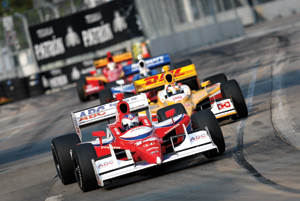Dan Wheldon’s death in the final race of the Izod IndyCar Series darkened what had been a strong 2011 season for the series on the business front.
Over the course of 17 races, the IndyCar Series averaged the most TV viewers in three years, increased average attendance by 10 percent, re-signed all five sponsors up for renewal and added five new sponsors for the season.
“The circumstances of Las Vegas unfortunately cloud a lot of the discussion, but by every [business] measure, they’ve had a dynamic year and are trending up,” said Chris Lencheski, the new president of Front Row Marketing Services and former CEO of Phoenicia Sport, which put together the deal for Telemundo to sponsor Newman/Haas Racing this year. “They have challenges still and the challenges remain that they have to increase the television audience … and they have to find markets where they can be celebrated, not just tolerated.”
 |
NEWSCOM
The new street race in Baltimore helped drive up total and average attendance for the year. |
IndyCar averaged 1.3 million viewers for 15 races across ABC and Versus this season, excluding a rain-postponed race in Brazil and the suspended race from Las Vegas. The average was the series’ best since Versus acquired its broadcast rights in 2009. Last year, IndyCar averaged 1.1 million viewers for 16 telecasts, which excluded a rain-postponed race from St. Petersburg, Fla.
On Versus, IndyCar averaged 402,000 viewers over 11 races, which was up 9.8 percent from 366,000 viewers over 12 races in 2010. On ABC, the series averaged 3.2 million viewers, up 17.2 percent from 2.7 million in 2010.
The series saw similar jumps in at-track attendance. Average attendance for the year was 97,852 and total attendance was 1,663,500, which were both up from the previous year’s totals of 88,805 and 1,509,677, respectively.
The attendance increases were driven by races in Sao Paolo, Brazil, which doubled attendance from 46,000 in 2010 to 100,000 in 2011, and Baltimore, a new street race that drew 150,000 spectators. Races in Milwaukee (25,000), Kentucky (30,000) and Las Vegas (30,000) drew the smallest crowds.
The increases came in a year that the series added double-file restarts, and challenged drivers from other series to race in the IndyCar championship for $5 million. At its races, IndyCar undertook a series of measures to make the event more fan-friendly, including bringing four LED leaderboards to street courses, reducing the minimum age for garage access to 9 years old, and building a small portable stage that crew members can use to explain what fans see in the garage.
At the start of the season, IndyCar CEO Randy Bernard said, “We want to give our fans value. We want to say, ‘We’ve had a tough eight years, but give us a chance and let us show you our sport again.’”
IndyCar had five sponsors up for renewal in 2011. Firestone, Peak Performance Motor Oil, National Guard, Philips and Honda all signed extensions.
Firestone was the only partner that threatened to walk away from the series. The tiremaker signed a two-year extension after Bernard put forward a proposal that reduced Firestone’s sponsorship cost and raised the price teams paid for its tires at races.
In addition to re-signing five partners, IndyCar added deals with the Boy Scouts of America; MGM Resorts; the Las Vegas Convention and Visitors Authority; Trim Nutrition, which develops vitamin supplements; and GreenFuel Technologies, which makes solar power equipment.
The series said that marketing and promotional spending by sponsors more than doubled from 2010 and exceeded $200 million this season. Its executives hope to push that spending higher in 2012 by adding more new sponsors. It is searching for sponsors in the financial services, health and wellness, green energy, alcohol and technology categories.




